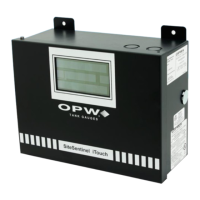12.1.2 Controller Setup for Hydrocarbon Liquid Sump Sensor
1. Configure the barrier position to be a generic sensor and install that position.
2. Use the controller to take a dynamic reading of the hydrocarbon part of the sensor.
3. Set the lower alarm threshold at 0.2 volts lower than the reading taken (if there is no existing
hydrocarbon contamination).
4. Set the upper alarm threshold at 5.0 volts (this will disable the upper threshold).
5. Program the alarms associated with the lower threshold that will activate if the sensor detects
hydrocarbon liquid.
12.1.3 Testing and Decontaminating the Hydrocarbon Liquid Sump Sensor
To prevent the possibility of explosion or fire, do not test the sensor in the
Hazardous Area.
Work in a well-ventilated area with no hot surfaces or open flames.
Do not use fuel to test the sensor!
• Test the Sensor
o Put the polymer fully into mineral spirits for about 10 minutes
o Remove the sensor and let it hang to air dry
o After another 10 minutes any Controller alarms or events associated with the hydrocarbon sensor
should start
o Disconnect this part of the sensor from the Controller. An alarm should occur immediately.
o Short across these Controller positions. An alarm should occur.
o If the open lead and/or short lead test results are unsatisfactory, examine all wiring and junction
boxes for continuity.
NOTE: If your controller does not sense the alarm conditions simulated here, examine your controller
thresholds to make sure they are correct.
• Clean the Hydrocarbon Sensor. To clean hydrocarbon contamination (as a result of testing or actual
use) from the sensor:
o Put the contaminated portion fully into denatured alcohol for one hour
o Flush the sensor with water to remove any residue
o Allow the sensor to “settle” for another hour
NOTE: The sensor should return to near its original resistance, though it may be necessary to readjust the
controller’s thresholds.

